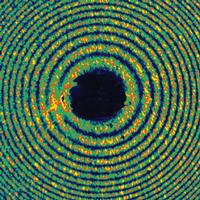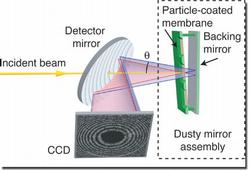A typical two-pass coherent diffraction pattern. (Credit: LLNL California press release)
Scientists from the Lawrence Livermore National Laboratory (LLNL), Center for Biophotonics Science and Technology at UC Davis, Stanford Linear Accelerator Center, Uppsala University in Swedan, TU Berlin, and DESY contributed to the study of femtosecond time-delay X-ray holography at FLASH. They used a simple holographic measurement scheme, inspired by Newton's 'dusty mirror' experiment, to monitor the X-ray-induced explosion of microscopic objects.
Newtons “dusty mirror” experiment
Newton created one of the earliest observations of interference in his “dusty mirror” experiment. In a darkened room, he used a prism and a small hole in a screen to form a quasi-monochromatic beam from sunlight, which he shone onto a back-quick silvered mirror. The mirror was angled to return the beam back through the hole and on the screen. Newton observed dark and light rings of light, which he found “strange and surprising.” It was 100 years later when the British scientist Thomas Young determined the rings were caused by interference at the screen between two paths of light scattering from dust particles on the mirror’s front surface.
X-ray mirror experiment at FLASH
Unlike the static conditions of Newton’s experiment, in the recent experiment the sample is placed near an X-ray mirror; after the pulse traverses the sample, triggering the reaction, it is reflected back onto the sample by the mirror to probe this reaction. The delay is encoded in the resulting diffraction pattern to an accuracy of one femtosecond, and the structural change is holographically recorded with high resolution. Coupled with the short wavelength of X-rays, the measurements give information simultaneously at the highest spatial resolution and time resolution for general noncrystalline materials beyond radiation damage limits for biological samples.
With upcoming ultrafast X-ray sources like the European XFEL reseachers will be able to explore the three-dimensional dynamics of materials at the timescale of atomic motion.
Their results appeared in Nature (August 2007).
(from: ...Paper and LLNL Press release)
The FLASH FEL pulse from the left passes through a hole in a multilayer-coated detector mirror. This "dusty mirror" consists of particles on a 20-nm-thick silicon nitride membrane backed by a multlayer-coated plane mirror. This returns the direct beam back through the hole in the detector mirror, which reflects the diffracted light onto a CCD detector. The prompt diffraction (blue, the reference wave) and delayed diffraction (red, the object wave) interfere to generate the hologram on the CCD detector. (Credit: LLNL California press release)
| Further Links |
|







